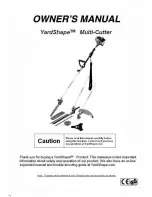
39
Revision date: 09.25.18
111628M
111628M Quick Start Guide: General Information
General Startup
Many factors must be considered before you begin growing fodder in your
new system. One of the best sources of information is the internet. Spend
as much time as needed to research how you want to get the most out of
your system. Each growing situation and fodder use is unique to the user. To
prevent frustration and wasted time, a few hours spent on the internet can
save you days or weeks in the field trying to achieve acceptable results.
Remember:
To achieve the results specific to your fodder needs, you must
experiment using your fodder system and record the results for reference.
This will help you to better understand how the system works, what
conditions are required to achieve maximum production, and how to adapt
and react to changes when these occur.
Here are a few items to consider before you get started:
• What animals (and how many) will eat the fodder?
• How often will you feed fodder to your animals?
• Where will you set the fodder system and what are the environmental
conditions of that location?
• Is water and electricity available for the fodder system?
• Is a floor drain near where the fodder system will be placed?
• Is the space large enough to allow easy harvest of the fodder and
maintenance of the system?
• Is there enough light (natural or artificial) to help the fodder grow?
• Will you be able to clean and maintain the system as required in the
location where the fodder system will be placed?
• What type of seed or grain will you grow?
• Have you found a supplier for your seed/grain?
• Will clean seed/grain be used, or do you plan to clean these yourself?
• How will you store the seed to prevent loss to rodents and pests?
• How will you transport the fodder from the system to the animals?
• Do you have access to products and information to help prevent mold
and fungus growth should these occur?
Mold Growth
Controlling mold growth is important if you want to produce healthy and safe
fodder. Here's one way to help keep your system mold-free:
1. Purchase bulk hydrogen peroxide (30%) and dilute with water to a 15%
solution. Store and handle as instructed on the container!
2. Purchase an injector (see photo below) and connect it to the main water
supply line to the fodder system.
3. Set the injector to inject the 15% hydrogen peroxide solution into the
water system. Use an injector setting of 1:100 to begin.
4. Monitor fodder growth and hydrogen peroxide use and adjust the injector
as needed to achieve the best results.
NOTE:
Although more time-consuming, a hydrogen peroxide solution can
also be applied using a hand or portable pump sprayer if an injector is not
used.
For this method, use a 1% to 3% hydrogen peroxide solution.
Inspect the sprouts and fodder for signs of mold and spray as needed.
Clean all channels thoroughly after harvest and before planting.
IMPORTANT:
Mold
grows best when heat
and humidity increase.
To inhibit mold growth,
maintain a cool, dry
growing environment
for the fodder. Frame
shown may differ from
actual frame.





































